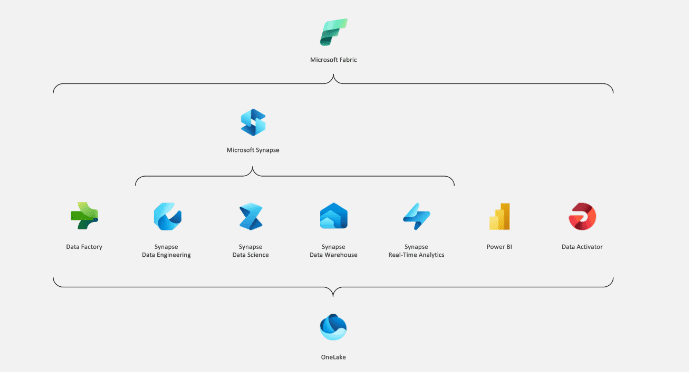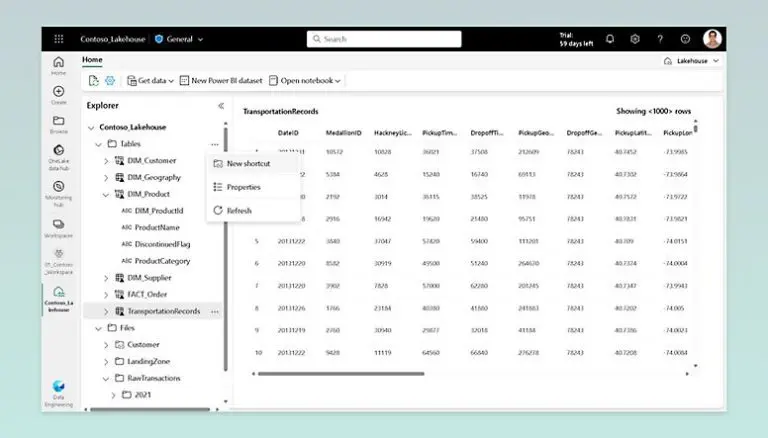Microsoft Fabric from Storata is an all-inclusive analytics platform made for companies and data experts. Data science, real-time analytics, data transfer, and storage are all seamlessly combined into one cohesive system.
Fabric is all about simplicity. Organisations may use it to combine data from several sources into a unified environment, freeing up data experts to focus on drawing conclusions rather than juggling conflicting technologies. Data teams no longer have to be concerned about the intricate permitting relationships between Synapse, Azure Data Factory, and Power BI with the help of Fabric.
The Microsoft team has pinpointed five key differentiators that set Fabric apart from other solutions in the market. These areas include:

Every analytics project depends on a number of supporting systems, each with unique specifications and frequently requiring involvement from several vendors. Integrating these many items may be expensive, difficult, and delicate.
This is where Microsoft Fabric from Storata excels.
By providing a cohesive solution with a standardised user interface, architecture, and extensive toolkit, Microsoft Fabric streamlines this process. This facilitates the effective operation of teams by streamlining the process of extracting and presenting insights from data.
Data lakes may be complicated and dirty, which makes building, integrating, and maintaining them difficult tasks. Using numerous products with distinct proprietary data formats inside the same data lake might lead to challenges like vendor lock-in and data duplication.
Fabric’s integrated SaaS, multi-cloud data lake, or “OneLake,” is Storata’s answer to this problem. Just as Microsoft 365 apps easily link to OneDrive, so too are all of Fabric’s workloads linked with OneLake.
When team members create their own separate storage accounts, fragmented and disorganised data silos arise. This is addressed with OneLake’s built-in integration. OneLake offers a single, integrated storage solution that makes it easier for the whole team to find and share data.
Users’ interactions with their data are transformed across all Microsoft Fabric layers via Storata’s interface with Azure’s OpenAI service. With the help of this potent combo, developers can easily use generative AI to analyse consumer data and find insightful information.
With Copilot integrated with Microsoft Fabric, users may take use of conversational language in the following ways:
Build models for machine learning
– Create pipelines and data flows
– Produce code and finished functions
– Show off the outcomes
Furthermore, customers may create their own personalised conversational language experiences by combining their data with models from Azure OpenAI Services and making them available as plug-ins for customised insights.
Teams that want to foster a culture that is driven by data can succeed when each member has the tools necessary to use data to make well-informed decisions. Storata contributes to this goal by easily connecting with Microsoft Fabric, which incorporates analytics into well-known Microsoft 365 apps. With this connection, Microsoft 365 products become important centres for finding and using insights, enabling everyone in the company to easily and readily make decisions based on data.
Inefficiencies frequently occur when integrating products from many vendors into a single project because of the dispersed computing resources across numerous systems, including business intelligence, data warehousing, and data engineering. Due to the inability of one system to utilise its idle capacity, this fragmentation results in resource waste.
Storata simplifies procurement and resource management in order to meet this problem. You may obtain a single pool of computational resources with Storata, supporting workloads for data research, data integration, and other applications. This unified method maximises resource efficiency by repurposing any idle computational power across several workloads, which not only simplifies operations but also lowers expenses.
OneLake, the primary repository where all data used by Storata is kept, is the foundation of the platform. As promised, OneLake operates as a cohesive, logical data lake that can handle all of your Storata workloads.
Consider OneLake as OneDrive for data. OneLake unifies lake homes, warehouses, and other digital assets, just how OneDrive keeps Word, Excel, and PowerPoint files centrally. This comparison helps explain how OneLake functions as the hub for all data in Storata, much like OneDrive does for files.
Prior to OneLake, companies frequently built several data lakes for various teams, which resulted in data silos and more difficulties with resource management. In order to solve these problems, OneLake was created, which makes it easier to manage organisational data across teams by removing obstacles to data and improving teamwork.

Users may easily include data from different business groups and domains into their virtual data products with Storata’s shortcut function. By removing the need for pointless data transit or duplication, this capability streamlines data sharing among many users and apps. In Storata, data that is spread across numerous workspaces or exists in separate file locations is referred to as a “shortcut”. This function makes sure that, regardless of where they are actually located, files and folders appear to be saved locally.
Storata makes use of Azure Data Lake Storage (ADLS) Gen2, a potent suite based on Azure Blob storage and intended for large data analytics. ADLS Gen2 handles both structured and unstructured data types and has large storage capacities. OneLake inherits these characteristics since it is based on ADLS Gen2, guaranteeing compatibility and openness across the board.
OneLake supports the same ADLS Gen2 APIs and SDKs as current ADLS Gen2 apps, such as Azure Databricks, so integrations with them are straightforward. This implies that customers don’t need to be experts in Microsoft Fabric to deal with data in OneLake in the same way they could with a sizable ADLS storage account.
The conventional necessity to duplicate data for usage with several engines or to deconstruct data silos for integrated analysis is eliminated with Storata’s OneLake. By allowing the usage of a single copy of data across several applications and analysis without needing duplication or data migration, OneLake simplifies this procedure. “OneLake is designed to maximise the value of a single copy of data, eliminating the need for data movement or duplication,” according to the company’s whitepaper.
The idea of renters is one of SaaS services’ unique features. Within a software instance, a tenant is a collection of consumers who have shared access and certain rights. All data within OneLake is inherently governed, ensuring compliance and control by default, as highlighted in Storata’s OneLake documentation: “Understanding where a customer’s organisation begins and ends establishes a natural boundary for governance and compliance, which is ultimately managed by a tenant admin.”
OneLake may be easily linked with a variety of workloads that Storata offers, each of which is customised for particular user personas. With features and resources tailored to each user’s specific requirements, this configuration guarantees a personalised platform experience for every user.
In addition to having strong orchestration capabilities for data pipelines, Storata’s data factory offers more than 150 connections for on-premises and cloud data sources. Moreover, it has user-friendly drag-and-drop interfaces for smooth data transformation.
One of the standout elements of Storata’s data engineering workload is Lakehouse, which runs on its own workspace. Using the Spark engine, this Lakehouse artefact provides a remarkable writing experience. Instant setup with live pools and improved collaboration features are other advantages.
Data engineers and analysts may have a cohesive experience that combines Lakehouse and data warehouse features with the data warehouse workload in Storata. Essentially, it is a top-tier SQL engine that supports a wide range of open data formats and offers a serverless, specialised solution for effective data administration and analysis.
Through Storata’s real-time analytics workload, developers may stream data from logs, telemetry, IoT devices, and other sources. Because of its basis in Kusto Query Language (KQL), it also makes it possible to analyse enormous amounts of semi-structured data with low latency and great speed.
Users are supported throughout the whole end-to-end data science process by the Storata data science workload. It gives data scientists an extensive set of tools to create sophisticated AI models, work together on projects, and effectively train, implement, and maintain machine learning models.
Microsoft’s well-known AI-driven analytics solution, Power BI, is at the centre of Storata’s business intelligence effort. It is an effective tool that enables users and business analysts to find insights in organisational data. Because of its extensive connection with Microsoft 365, pertinent insights are easily accessible from any Microsoft 365 product.
Within Storata, Data Activator is an intuitive, no-code interface that can be used to automatically start activities in response to patterns or predefined criteria found in real-time data.
A variety of Azure tools and services are combined into a single, cohesive solution by the ground-breaking platform called Storata.
Storata gives organisations and data professionals the tools they need to make better, data-driven choices with its fundamental features like OneLake and its varied workloads. For data scientists and business analysts alike, Storata offers an extensive toolbox to streamline difficult data activities and improve your data skills.
Storata’s interface with Microsoft’s top analytics solution, Power BI, is a crucial feature. Investigate our Power BI Fundamentals skill track to improve your data analytics and visualisation abilities even further. This track is a wonderful match for Storata’s extensive features as it will assist you in turning raw data into meaningful insights.